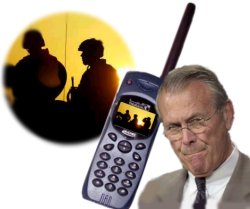Tuesday, February 03, 2004
As April, the cruelest month, began last year, the week old Iraq war was looking increasingly grim.
Without regard to the ferocity of the first week’s battle, embedded TV journalists in front line units were beginning to mention supply problems.
Some troops were rationing their supply of MREs and water, while others mentioned the lack of blankets to combat the bitter chill of desert nights.

One could sense the embedded, finding empathy after field baptism, had a stake in the newly discovered supply problem.
Important CNN viewers on both sides of the Potomac, that particular morning, must have noticed and begun important countermeasures.
From the March 30, 2003 edition of USAToday:
Journalists covering the war in Iraq scrambled over the weekend to connect with their news services after the U.S. military banned the use of certain satellite phones…The ban is for only Thuraya phones, which have built-in Global Positioning System (GPS) features…Reuters news service, correspondent Matthew Green said: "They say it's for security, that the Iraqis can use it to triangulate the signal and fire missiles." News outlets have raised objections with the Pentagon, but so far the military has not made clear the exact threat the phones pose.
Once satellite transmissions, on approved phones, resumed, front line embedded reportage seemed muted and progressively more infrequent.

These photos, on the Thuraya page of Outfittersatellite.com shows CBS affiliate WTVF reporter and Thuraya user Dana Kaye embedded with the Army’s 2nd Battalion, 187th regiment of the 101st Airborne Division…Their unit’s mission was to establish and defend Rapid Refueling Point Exxon, 30 miles south of Nasiriyah.
Secretary Rumsfeld and General Myers in a live press conference on Tuesday April 1, 2003 lashed out against critics and insisted The Plan was on track; that soldiers were racing ahead while an unrepresentative few griped exclusively for reporters.
A New York Times report on the press conference described it as dramatic:
Myers rapped on the lectern with a clenched fist. He angrily mocked criticism…Striking back at the officers who have criticized the war plan…Myers said they were not "responsible members of the team that put this all together”…He said: "They either weren't there, or they don't know, or they're working another agenda…Myers also reprimanded journalists for analyzing, criticizing and reporting anonymous dissent on a secret war plan they had never seen.
That same April 1, 2003 NYT report, on the Milwaukee Journal-Sentinel Website, contained this comment from retired General Barry M. McCaffrey:
The problem isn't that…serving officers are commenting, or that retired senior officers are commenting on television. The problem is that they (creators of The Plan) chose to attack 250 miles into Iraq with one armored division and no rear-area security and no second front."
The Defense Secretary, always with a savvy eye toward History, suggestively said at this dramatic press conference that he could not take credit for The Plan:
Gen. Tommy R. Franks drafted the plan, and the Joint Chiefs of Staff and the National Security Council vetted it.
At a safe arms length, we presume, for those at Cabinet rank and above, Lean and Mean had to work for the success of The Plan and the triumph of empire.
It didn’t matter that embedded reports indicated ground commanders were advocating a pause and regroup.
By April 4, 2003 Colonel Joe Dowdy, commander of Marine Combat 1, had been historically removed from battlefield command and virtually erased from existence.
Front line embeds vanished as the Red Zone loomed.
The Plan reigned supreme.
Imagine my surprise to read this morning’s New York Times an account of the first official Army history of the Iraq war:
American forces were plagued by a "morass" of supply shortages, radios that could not reach far-flung troops, disappointing psychological operations and virtually no reliable intelligence…Logistics problems, which senior Army officials played down at the time, were much worse than have previously been reported…Tank engines sat on warehouse shelves…trucks were scavenged…Artillery units cannibalized parts from captured Iraqi guns…Army medics foraged medical supplies…soldiers improvised solutions to keep the offensive rolling.
Photos: Reuters, Outfittersatellite.com

